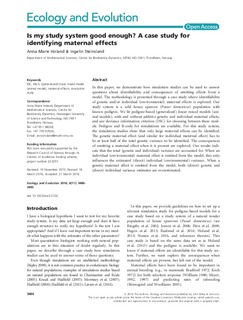| dc.contributor.author | Holand, Anna Marie | |
| dc.contributor.author | Steinsland, Ingelin | |
| dc.date.accessioned | 2020-03-04T12:02:51Z | |
| dc.date.available | 2020-03-04T12:02:51Z | |
| dc.date.created | 2016-04-22T09:19:23Z | |
| dc.date.issued | 2016 | |
| dc.identifier.citation | Ecology and Evolution. 2016, 6 (11), 3486-3495. | nb_NO |
| dc.identifier.issn | 2045-7758 | |
| dc.identifier.uri | http://hdl.handle.net/11250/2645208 | |
| dc.description.abstract | In this paper, we demonstrate how simulation studies can be used to answer questions about identifiability and consequences of omitting effects from a model. The methodology is presented through a case study where identifiability of genetic and/or individual (environmental) maternal effects is explored. Our study system is a wild house sparrow (Passer domesticus) population with known pedigree. We fit pedigree‐based (generalized) linear mixed models (animal models), with and without additive genetic and individual maternal effects, and use deviance information criterion (DIC) for choosing between these models. Pedigree and R‐code for simulations are available. For this study system, the simulation studies show that only large maternal effects can be identified. The genetic maternal effect (and similar for individual maternal effect) has to be at least half of the total genetic variance to be identified. The consequences of omitting a maternal effect when it is present are explored. Our results indicate that the total (genetic and individual) variance are accounted for. When an individual (environmental) maternal effect is omitted from the model, this only influences the estimated (direct) individual (environmental) variance. When a genetic maternal effect is omitted from the model, both (direct) genetic and (direct) individual variance estimates are overestimated. | nb_NO |
| dc.language.iso | eng | nb_NO |
| dc.publisher | Wiley | nb_NO |
| dc.rights | Navngivelse 4.0 Internasjonal | * |
| dc.rights.uri | http://creativecommons.org/licenses/by/4.0/deed.no | * |
| dc.title | Is my study system good enough? A case study for identifying maternal effects | nb_NO |
| dc.type | Journal article | nb_NO |
| dc.type | Peer reviewed | nb_NO |
| dc.description.version | publishedVersion | nb_NO |
| dc.source.pagenumber | 3486-3495 | nb_NO |
| dc.source.volume | 6 | nb_NO |
| dc.source.journal | Ecology and Evolution | nb_NO |
| dc.source.issue | 11 | nb_NO |
| dc.identifier.doi | 10.1002/ece3.2124 | |
| dc.identifier.cristin | 1351868 | |
| dc.description.localcode | © 2016 The Authors. Ecology and Evolution published by John Wiley & Sons Ltd. This is an open access article under the terms of the Creative Commons Attribution License, which permits use, distribution and reproduction in any medium, provided the original work is properly cited. | nb_NO |
| cristin.unitcode | 194,63,15,0 | |
| cristin.unitname | Institutt for matematiske fag | |
| cristin.ispublished | true | |
| cristin.fulltext | original | |
| cristin.qualitycode | 1 | |

